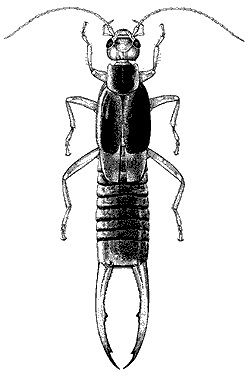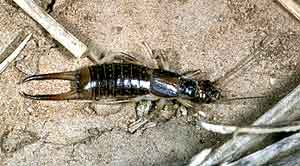|
Dermaptera:
earwigs
Characteristics
Earwigs
are a distinctive group of insects of small to medium size, ranging
from 5 to 50 millimetres in length. Earwigs are sometimes confused
with Staphylinid beetles, but can be distinguished from the latter
by the presence of pincer-like cerci, which Staphylinid beetles
lack. Earwigs are mostly dark coloured (brown to black) and can
be recognised by the following features:
|

Labidura truncata (LABIDURIDAE)
|
|
- Heavily sclerotised
pincer-like cerci.
Females have straight cerci with a inward pointing tip and males
have curved cerci
- 2 pairs of
wings. The forewings are short and protectively hardened. The
hind wings are membranous
and folded in a fan-like way underneath the forewings when not
in use. Some species are also wingless
The LABIDURIDAE
family of earwigs consists of relatively primitive species that
are predominantly a red-brown colour and range from 10 to 45 millimetres
in length. Members of this family are found all over Australia.
Labidura truncata is by far the commonest species, particularly
in sandy habitats. It is approximately 35 millimetres long and dull
brown with straw coloured markings. The male have long slender pincers
with a distinctive tooth near the middle of the inner edge.
The name 'earwig'
come from a European myth that these insects had a habit of crawling
into human ears. However the name most likely comes from the term
'ear-wing', referring to the shape of the hind wing.
Life Cycle
Earwigs
mate end to end, often grasping each other's pincers, Female earwigs
are able to store sperm for several months before fertilisation.
A female will lay hers eggs in a burrow she has excavated or in
natural crevices in the soil, where she will stand guard protectively
until the young hatch. The female guards the eggs from predators
and constantly turns and cleans them, preventing fungus diseases.
Upon hatching the young earwigs resemble small adults and remain
under the protection of their mother for a short period of time.
They must then disperse to new areas or risk being eaten by her.
Feeding
Most species
of earwigs are omnivorous
and eat a wide variety of plant and animal material. Many species
live primarily on a diet of plant matter, both living and decaying.
They also consume dead insects and other organisms, while some species
prey on live insects. The cerci
are often used to hold food and carry prey after it has been killed.
|

Labidura truncata inland form (LABIDURIDAE)
|
Labidura
truncata is a large native earwig that prefers to feed on soft-bodied
caterpillars both larger and smaller than themselves. It grabs a
caterpillars with its pincers and holds it there while feeding.
L.truncata may also feed on other insects, including other earwigs
if it is hungry enough.
Habitat
Earwigs
are commonly found in dark, sheltered environments and are common
under rocks, logs and the bark of trees. They are common over most
of Australia and many species frequent suburban backyards and homes.
Earwigs are nocturnal
and may often be attracted to lights at night.
|


